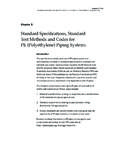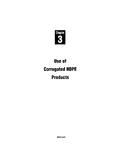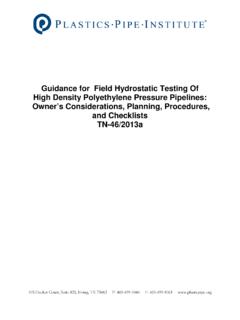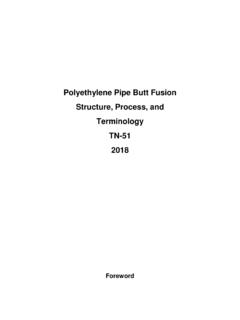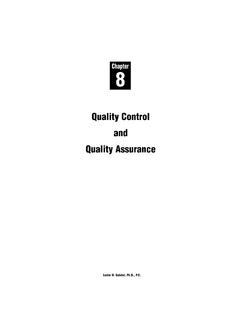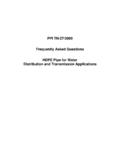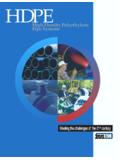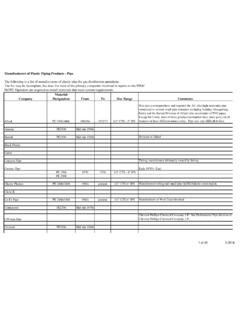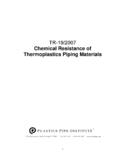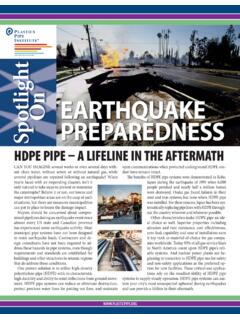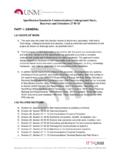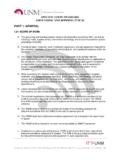Transcription of Chapter 14 - Duct and Conduit - Plastics Pipe Institute
1 Chapter 14 Duct and Conduit473 Chapter 14 Duct and ConduitIntroductionThe general purpose of Conduit , or duct, is to provide a clear, protected pathway for a cable, or for smaller conduits, sometimes called innerducts. Advances in cable technologies, as well as the expense of repairing sensitive cable materials like fiber optic cable, have driven preferences for protective Conduit over that of direct burial. Polyethylene (PE) Conduit provides mechanical protection to fragile cable materials like fiber optic and coaxial cables, as well as protection from moisture or chemicals and even, in some cases, animals. Furthermore, the permanent pathway provided by Conduit also facilitates replacement projects or future installations of additional cable or duct. Buried Conduit evolved from terracotta tile, cast concrete and Transite to Plastics in the 1960s. Originally, PVC was utilized, but ultimately, PE has emerged as the material of choice due to its distinct advantages in installation options, versatility and Conduit can be installed below ground by a variety of methods, including open trench, plowing, continuous trenching and directional drilling.
2 Also, its flexibility and availability in continuous coiled lengths facilitates installation into existing conduits or ducts as innerduct. In addition PE Conduit provides many above ground or aerial SpecificationsThe following specifications are utilized by the industry for the production of Conduit and Raceways: Telecommunication Conduits ASTM F2160 Standard specification for Solid-Wall High Density Polyethylene (HDPE) Conduit Based on Controlled Outside Diameter (OD) 4731/16/09 10:17:17 AMChapter 14 Duct and Conduit474 Power Conduits ASTM F2160 Standard specification for Solid-Wall High Density Polyethylene (PE) Conduit Based on Controlled Outside Diameter (OD) NEMA TC7 Smooth-wall Coilable Polyethylene Electric Plastic Conduit Electrical Conduits UL 651A Type EB and A Rigid PVC Conduit and PE Conduit UL 651B Continuous Length PE Conduit Premise Raceways UL 2024 Optical Fiber Cable RacewayApplicationsPE Conduit serves two primary industries.
3 Communications (telephone, CATV, data transmission) and electrical (power transmission).In the communications industry, the advent of fiber optic cable has had a tremendous impact due to its significantly higher data-carrying capacity, particularly due to the explosion of the Internet. In telecommunications service (phone, data transmission), fiber optic cable is used, along with traditional copper cable. In cable television service (CATV), fiber optic is also growing rapidly in addition to (or replacing) coaxial cable. This progression toward fiber optic cable has made the need for protection more critical, since these materials are highly sensitive to moisture and mechanical stress. Damage can be very expensive in terms of interrupted service and replacement costs. Also, these cables are installed in very long, continuous runs which require a clear, protected pathway, as well as a leak-free system for air-assisted ( blow-in ) installations.
4 In addition to fiber optic, coaxial cables have seen improvements to increase bandwidth, making these materials more mechanically the electrical industry, a critical requirement is on maintaining uninterrupted service, as consumers and businesses are even less tolerant of power outages than they are of phone or CATV service interruptions. Although many direct-buried power cable systems are designed for 30- or 40-year lifetimes, they are susceptible to external influences like rock impingement and often require frequent repairs. Conduit is finding favor over direct burial in these applications due to improved protection, but it must be continuous and facilitate quick repair operations. PE Conduit is used to carry both primary (substation to transformer) and secondary (transformer to end-user) cables. Some of these installations also contain fiber optic cables placed alongside the power cables to connect with load-monitoring sensors located throughout the network.
5 Advantages of PE ConduitHigh Density Polyethylene (PE) is the most commonly used PE material for Conduit . PE Conduit delivers significant physical property advantages over other Conduit 4741/16/09 10:17:17 AMChapter 14 Duct and Conduit475 Ductility - tough, PE Conduit will better resist brittleness with age or cold weather. Low temperature impact resistance PE withstands low temperature impact better than any other material. This is illustrated by impact testing on PE Conduit conditioned at 4 F as compared to other materials conditioned at 73 F. Permanent flexibility PE Conduit bends and flexes without breakage, even with ground heaves or shifts, over a wide range of temperatures. Temperature versatility PE Conduit can be installed over an ambient temperature range of -30 F to 180 F. Power conductors rated at 90 C and medium voltage cable rated at 105 C are permitted for use with PE Conduit .
6 InstallationFlexible PE Conduit can be wound onto reels several thousand feet long, does not require manufactured bends, and can be easily navigated around unexpected obstructions (in the ground or within existing ducts), simplifying installation. The few joints that are required can be made reliably through a number of Conduit is suitable for all methods of duct and cable installation, including trenching, direct plow and installation into existing main pathways ( Conduit pulling, sliplining and pipe bursting). Also, the flexible nature of PE Conduit facilitates directional bore installations to breach obstacles like rivers or highways. Cable can consistently be pulled or blown into PE duct in great distances and at fast rates due to its low coefficient of friction. Special PE products and accessories are also available for above ground or aerial variety of PE Conduit products are available for special applications.
7 Multiple ducts of different color/stripe combinations and sizes can be delivered on one common reel, for a more efficient installation. Pre-installed Cable-in- Conduit (CIC) saves time and labor by allowing one-step placement of both cable and duct. The integrity of the cable is protected during the installation process by the PE duct. Testing prior to and after the duct has been extruded around cable is performed to ensure no performance loss. Cable-in- Conduit can be provided with fiber, coaxial, twisted pair and electrical cables. Corrugated innerduct is flexible, lightweight with a low coefficient of friction. Ribbed Conduit (longitudinally or spiral) provides friction reduction in cable installation. Self-supporting duct includes a suspension strand already built into the duct for greater dimensional stability and ease of installation in the aerial plant. 4751/16/09 10:17:17 AMChapter 14 Duct and Conduit476 Deployment of ducts aerially allows for enhanced protection for the cable and allows for less costly cable repairs and capacity upgrade SelectionThe primary physical property advantages of PE Conduit are flexibility, ductility and chemical resistance.
8 Other physical attributes critical to the performance of PE Conduit are tensile strength and stress crack resistance. However, the designing or specifying engineer should be aware that not all PE materials deliver the same level of performance in these areas, and it is critical to ensure that the material meets all the demands of the installation and service conditions. This section will briefly discuss these material considerations, but a more thorough discussion of PE technology is provided in the Chapter on engineering properties of polyethylene in this PropertiesCell ClassificationThe Cell Classification (ASTM D 3350) is a 6-digit numeric code which describes an PE Conduit material s performance level in six key physical characteristics. This 6-digit classification often includes a single letter suffix representing a color or UV stabilizer category. This cell classification is used in specifications such as ASTM F2160 Standard specification for Solid Wall High Density Polyethylene (PE) Conduit Based on Controlled Outside Diameter (OD).
9 Each property is broken into 4-6 specific performance PE density generally has the greatest effect on many physical properties. For example, higher densities favor increased tensile strength and stiffness, while lower densities generally favor impact resistance, and flexibility and stress crack resistance. Density also affects coefficient of friction (COF see Section 7), with higher density typically related to lower COF. Therefore, some degree of compromise may be necessary to balance properties required for a particular Index Melt Index (MI), a measurement of a polymer s molten flow properties (ASTM D 1238), is related to molecular weight, or the length of the individual polymer chains. Generally, lower melt indices represent higher molecular weights while higher values indicate lower molecular weights. For any given PE resin, a lower melt index (higher molecular weight) will normally have superior physical properties.
10 Flexural Modulus Flexural modulus is a measure of a plastic s stiffness, or its resistance to bending or deflection under applied load. In PE Conduit , these stiffness 4761/16/09 10:17:17 AMChapter 14 Duct and Conduit477characteristics generally affect load-bearing capability, bending radius, and tendency to ovalize (when coiled or bent). Flexural modulus should be taken into account when determining the appropriate wall thickness for an Strength/Yield Strength Tensile yield strength, or the point at which a stress causes a material to deform beyond its elastic region (irreversible deformation), is a critical property for many Conduit installation methods involving pulling ( , directional drilling). Yield strength can limit the rates or lengths of such installations (see page 7 Design Considerations), and it is an important consideration in determining allowable pull loads. It is important to note that both flexural modulus and tensile strength are affected by temperature (both decrease with increasing temperature).
